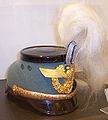shako

The shako is a predominantly military headgear with a cylindrical or conical shape. Usually it has an eye and sometimes a neck umbrella. Towards the end of the 18th century, the shako was created from the wing cap of the hussars (in Prussia "Schackelhaube"). The Hungarian word csákó means "hussar helmet". The peaked cap and kepi were developed from the shako by reducing the size and saving on material .
The shako was used as headgear by the police in Germany from 1918 to the mid-1960s .
In the drum corps scene this headgear is common and the English spelling and pronunciation Shako ([ ʃækoʊ ], [ ʃeɪkoʊ ], or [ ʃɑːkoʊ ]) are common.
material
Initially, the shako was made of felt , later completely or partially made of leather to protect the wearer from saber blows. In addition, there was often a metal chinstrap (scale chain) that offered additional protection. Felt and leather were usually black, and felt in different colors was used especially by the Hungarian hussars. For the police, the body was usually made of vulcanized fiber .
history

military
During the Napoleonic Wars , the shako prevailed in almost all European armies as the main headgear for foot troops , light cavalry and artillery , as it offered better protection than the felt hat common at the time. In addition, it was cheaper to manufacture than the leather helmets worn in Austria and Württemberg , for example . On the front was a metal fitting and usually a cockade-like standard, the so-called national . A neck made of hair or feathers could be attached to parades .
In Germany, the shako was largely displaced by the Pickelhaube in the Prussian Army from 1843 , so that until the outbreak of the First World War it was only used by the hunter troops , machine gun departments, parts of the technical special forces such as aviators, airmen, telegraph troops, Sea battalions ( marine infantry ), Landwehr and Landsturm used as well.
In the Empire of Austria introduced in 1806, the shako in modified form was (eg infantry models M1871 and M1891.) Since 1868 only to parade in the security service (if not the field cap was ordered), the ordinance - and inspection services as well as in some garrisons are also worn out of service on Sundays and public holidays. In the field and for daily duty, however, a headgear , initially called a camp cap and then called a field cap from 1871 , was mandatory .
In the majority of the armies the development was similar. Today the shako is still worn for representational purposes by guard units (e.g. Russia , Argentina ) or military academies (e.g. West Point or St. Cyr ).
In Belgium , a black felt shako was still being worn by the line infantry in 1914 . On its front was a regimental number embossed in brass. In battle, a black oilcloth cover was pulled over the shako, on which the regimental number was painted in white. In addition, a red wool pompon was attached to the front cover .
police
As part of the police uniform, the shako was not in use in Germany until the end of the First World War; Police and gendarmeries in the federal states of the German Empire usually wore the spiked hood as headgear . The shako came to the police in Germany via army hunter units that performed police duties in revolutionary Berlin in 1919 . During the Nazi regime , the police star with the coat of arms of the federal states was replaced by a sovereign eagle with a swastika that took up the entire front . Gendarmerie law enforcement officers wore it in medium brown leather instead of black. After 1945 the shako remained part of the police uniform in the British occupation zone , in Berlin and the Soviet Zone / GDR . In 1962 a ministerial order to abolish it was issued in the GDR, the implementation of which in East Berlin dragged on until 1964. The West Berlin police abolished the shako in 1968. In North Rhine-Westphalia the shako was worn until the early 1970s.
Shako of the Austrian artillery, ca.1900
Shako of the Prussian Guardsmen around 1910
Parade -Tschako for a general of the Ordnungspolizei, circa 1940
literature
- Laurent Mirouze: Infantrymen of the First World War. Verlag Karl-Heinz Dissberger, Düsseldorf 1990, ISBN 3-924753-28-8 .
- Erich Radecke: History of the police shako. From the old army to the police. Publishing house German Police, Hilden / Rhineland 1981, ISBN 3-8011-0110-X .
Web links
Individual evidence
- ↑ Rocking hood . Meyers Großes Konversations-Lexikon , Volume 17. Leipzig 1909, p. 665. Information from Zeno.org , requested on February 6, 2020.
- ^ The German People's Police after the founding of the GDR . Information from the website www.sachsen-polizeigeschichte.de , accessed on June 6, 2019.
- ↑ Birgitt Eltzel: Ex-Policeman shows collection about the GDR People's Police . Berliner Zeitung from January 10, 2007.
- ↑ Tschako 1945-1968 . Information from the Berlin Police Historical Police (PHSB) website , accessed on June 6, 2019.




